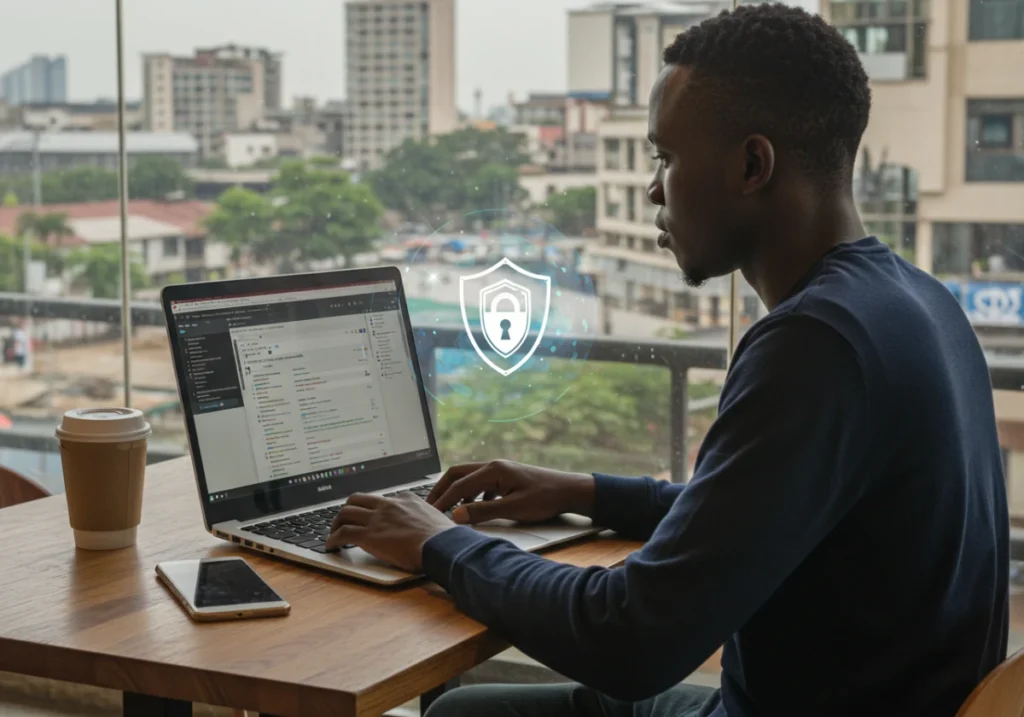Manasseh Adina – Web Developer
How to Secure Your WordPress Website in Kenya: A Hack Recovery Story
Quick Steps To Secure Your WordPress Website:
- Change default login URL + lock admin
- Update WordPress core + plugins immediately
- Install firewall & malware scanner plugin
- Backup daily and test your restore
- Use a strong host with secure file permissions
Hey there, fellow WordPress website warriors! If you’re building sites for clients, you’ve probably hit a snag or two (or ten). Maybe a site crashed, or worse, got hacked. I’ve been there, and I’m here to walk you through my rollercoaster of saving a client’s site from the infamous Japanese Keyword Hack, plus share practical tips on how to secure your WordPress website projects in Kenya.
Grab a coffee (or some chai, Kenyan style), and let’s dive into this mentor-mentee chat—because we’re in this together!
The Setup
I’m sipping a mocha at Artcaffe in Westlands, Nairobi, meeting a new client, Jane Doe. Jane’s got this fire for her beauty and wellness brand. She wants to create a huge brand for natural skincare products through blogs to educate Kenyans on skin health from a young age. She’s already done some legwork: bought a domain, set up a WordPress website on Bluehost, and even published a blog. She sounds like a dream client, right?
But when she hands me her iPhone to check out the website, my heart sinks. No navigation menu—visitors are lost. The template’s margins are very narrow, with text hugging the screen’s edges like it’s scared to breathe. And the homepage copy? Straight out of a generic American template, which is irrelevant to her Kenyan audience.
The homepage had plenty of words like “Shop our Fall collection!” when Nairobi mostly has sunny vibes all year-round.
I gently point out these flaws, suggesting a fresh design with local flavor and better UX. Jane’s all in—she’s passionate and trusts my vibe. We seal the deal, she shares her Bluehost access, and I send over a contract and quote. Game on!
The Build: Where It All Started
Back at my desk, I dive into the website development project. Jane’s a small business, so we keep it lean: Home, About, Shop, Blog, Contact. I scrapped the old WordPress install (too messy) and set up a fresh one with a theme I’ve mastered—clean, mobile-first (96.1% of Kenyans are mobile users, per our stats).
Here’s where I dropped the ball, and I’m owning it: during the WordPress setup, I used “admin” as the username and “password” as the password. It’s a rookie move, I know. I thought, “I’ll change it later.” The unfortunate thing is “Later” never came, and it bit me hard.
The build goes smoothly. I craft a site that screams Kenya—think vibrant colors, Modern beauty accents, and copy like “Glow with nature, Nairobi style.” We publish a blog, Jane loves it, and I suggest she start social media videos to boost her brand (she’s a natural!).
The site’s live, sales are possible, and we’re both satisfied. Progress, baby!
The Nightmare: A Website Hack Hits Hard
One week later, my phone pings. It’s Jane with a WhatsApp screenshot: “There has been a critical error on this WordPress website.” My stomach gets butterflies. I’m two years into this game, so I stay cool and respond to her: “Hi Jane, let me check and get back to you.”
I try accessing the backend—boom, “You do not have permission to access this page.” Weird. I attempt server-level access (no login needed)—same error. At this point, panic creeps inside me. Then I check Google Search Console, and my jaw hits the floor: 800+ URLs in the sitemap. For a site with maybe 20 pages, including products? No way.
It’s the Japanese Keyword Hack—a nasty attack that spams your site with malicious pages, bloats your sitemap, and redirects users to sketchy sites via SERPs. I’d heard about it (we’ve blocked 10+ attacks for clients at D4A), but seeing it on my project? I never thought this day would come.
Step 1: Secure your login
I jump into fix mode. First, I back up the site (always do this!), then I delete the WordPress website install, and restore the backup, thinking it’ll flush the malware. It works—for 24 hours. Then Jane sends another screenshot with the same error. My frustration level hits 100.
I’m sweating now. Jane’s paid me, and her brand’s stalled. I hit up Bluehost’s support chat through their client website, pouring out my woes. They’re helpful, cleaning detected malware and restoring the site. But like a bad movie sequel, the errors return hours later. I try Bluehost again—same cycle. They could only offer temporary fixes with no lasting solution. I’m starting to feel like I’m letting Jane down, and that’s not how we roll at Digital4Africa.
Step 2: Choose a secure host and file permissions
After three rounds with Bluehost, I run out of patience. Their firewall’s too weak for this hack, and I suspect my “admin/password” blunder left the door wide open. I call Jane, and we’re back at Artcaffe (our unofficial office). I level with her: “We need to switch hosts. Bluehost’s not cutting it. I recommend a rock-solid host with better security.”
Jane’s frustrated but trusts me—she’s all in for her brand. Right there, she buys a new hosting plan with my recommended provider (let’s call it SecureHost for now). She’s eager to get her site back ASAP. I promise to transfer the domain and restore everything fast.
Back home, I start the domain transfer, hyped to fix this mess. Then, the universe laughs at me with a joker card just after I yelled “Niko kadi!”. Domains can’t transfer until 60 days after purchase. Jane’s domain is only 50 days old. Now I’m stuck, and she’s just paid for new hosting.
Step 3: Set up backups and malware scanning
Sitting in my frustration, it hits me that reinstalling backups isn’t enough. The hack’s likely hidden deep into the files, sneaking back each time. The only way out now is to Build a new WordPress website from scratch. My heart sinks—I’d poured hours into a luxe design with custom touches. Starting over feels like climbing Kilimanjaro in flip-flops.
But then, a lightbulb moment hits me. I normally use offline dev software (like LocalWP) to build sites before deploying. My backup’s there, clean and untouched. I can load it, copy the code for each page (Home, Shop, etc.), and recreate them on a fresh WordPress install. I now it’s tedious, but it’s my only lifeline.
I dive in, working through the night. New install on SecureHost, new theme, same design vibes—Kenyan flair, mobile-first. I start pasting the code, tweaking the CSS, and testing every link. In 24 hours, the site’s live again. Jane checks it out, and boom—she even scores a sale! We’re back in business, baby!
How I Secured the Site With No More Rookie Mistakes
This time, I’m not messing around. Here’s how I locked down Jane’s site to prevent another hack:
- Ditched “admin/password”: Deleted that user, created a new one with a username like “jane_d4a_2025” and a password with special characters (e.g., “K3nya!Wp#2025”).
- Custom Login URL: Changed wp-admin to something obscure (e.g., “/jane-secret-login”) using a plugin like WPS Hide Login.
- Wordfence Plugin: Installed Wordfence for real-time monitoring, malware scans, and brute-force protection. Set up 2FA for my account—extra layer, no regrets.
- Web Firewall: Configured a firewall to cap requests per minute (e.g., 60/min per IP), blocking bots.
- Plugin Hygiene: Kept only active, updated plugins (e.g., WooCommerce, Rank Math). Deactivated the rest.
I shared these updates with Jane, walking her through each step to rebuild her trust. We published a new blog—same vibe as her original, but now on a secure site. Her brand’s rolling again, and I’m sleeping better.
5 Tips to Secure Your WordPress Website in Kenya
Alright, mentor-mentee time—let’s talk about how you can keep your clients’ WordPress websites hack-free. These are hard-earned lessons from my kurambwa, tailored for Kenyan developers like us:
- Never Use “Admin” or Weak Passwords
- This was my biggest mistake. Use unique usernames (e.g., “clientname_year”) and strong passwords with letters, numbers, and symbols (e.g., “Nairobi#Wp25!”). Try a 2FA password manager like Google Authenticator to stay organized.
- Pro Tip: Change credentials right after setup—don’t wait like I did.
- Hide Your Login Page
- Default wp-admin is a hacker’s first stop. Plugins like WPS Hide Login let you set a custom URL (e.g., “/my-secret-kenya”). Share it only with your client.
- Why It Matters: Bots can’t guess what they don’t know.
- Install a Security Plugin Like Wordfence
- Wordfence is a lifesaver—scans for malware, blocks suspicious IPs, and offers 2FA. The free version is solid for SMEs.
- Kenyan Angle: With hacks like the Japanese Keyword Hack hitting local sites, real-time protection is non-negotiable.
- Keep Plugins Lean and Updated
- Only install what you need (e.g., WooCommerce for shops, Rank Math for SEO). Check for updates weekly—old plugins are hack magnets.
- Quick Hack: Use WP Dashboard’s “Updates” tab to stay on top.
- Choose a Secure Host
- Not all hosts are equal. Bluehost let me down with weak firewalls. Pick one with strong security (e.g., Hostinger).
- For Kenya: Look for hosting packages with a CDN support—faster sites mean happier clients (and Google loves speed).
Do you want to dive deeper into building secure, stunning WordPress websites? Check out Digital4Africa’s WordPress Website Development Course starting May 5, 2025. It’s a 2-month hands-on program where you’ll master themes, security, and client wins—perfect for leveling up your projects. Visit the wordpress website development course landing page to grab your spot!
What I Learned (and You Can Too)
This experience was a wake-up call. I went from “I’ve got this” to “Oh no, it’s broken” to “We’re back!” in a whirlwind. Here’s the real talk:
- Own Your Mistakes: That “admin/password” goof? Mine. Admitting it to Jane and fixing it built trust.
- Backup Everything: My offline backup saved me. Use plugin tools like All-in-One WP Migration or keep local copies.
- Stay Proactive: Security isn’t a one-and-done. Regular checks (e.g., Wordfence scans) keep hacks at bay.
- Trust Your Gut: When Bluehost kept failing, switching hosts was the right call, even if it meant extra work.
As Kenyan developers, we’re building for a market that’s exploding—22.71M internet users by 2025, per our stats. But with growth comes risk. Hacks like the Japanese Keyword Hack are real, especially for SMEs who can’t afford downtime. By securing your WordPress websites, you’re not just saving code—you’re saving dreams, like Jane’s beauty brand.
Your Turn: Build Hack-Proof Sites
I hope my story’s got you fired up to lock down your projects. Start small: check your usernames, update your plugins, maybe run a Wordfence scan today. If you hit a hack, don’t panic—back up, rebuild, and secure smarter. You’ve got this, and I’m rooting for you.


